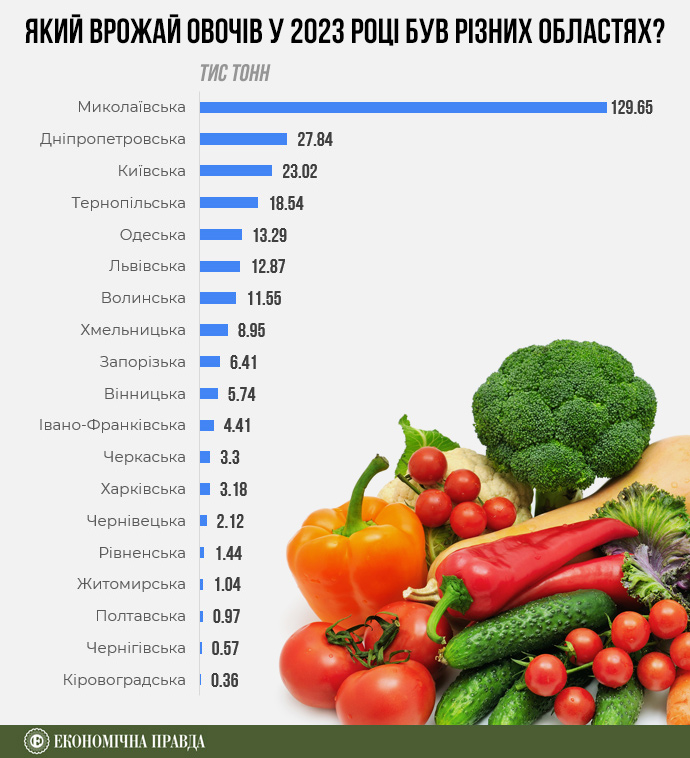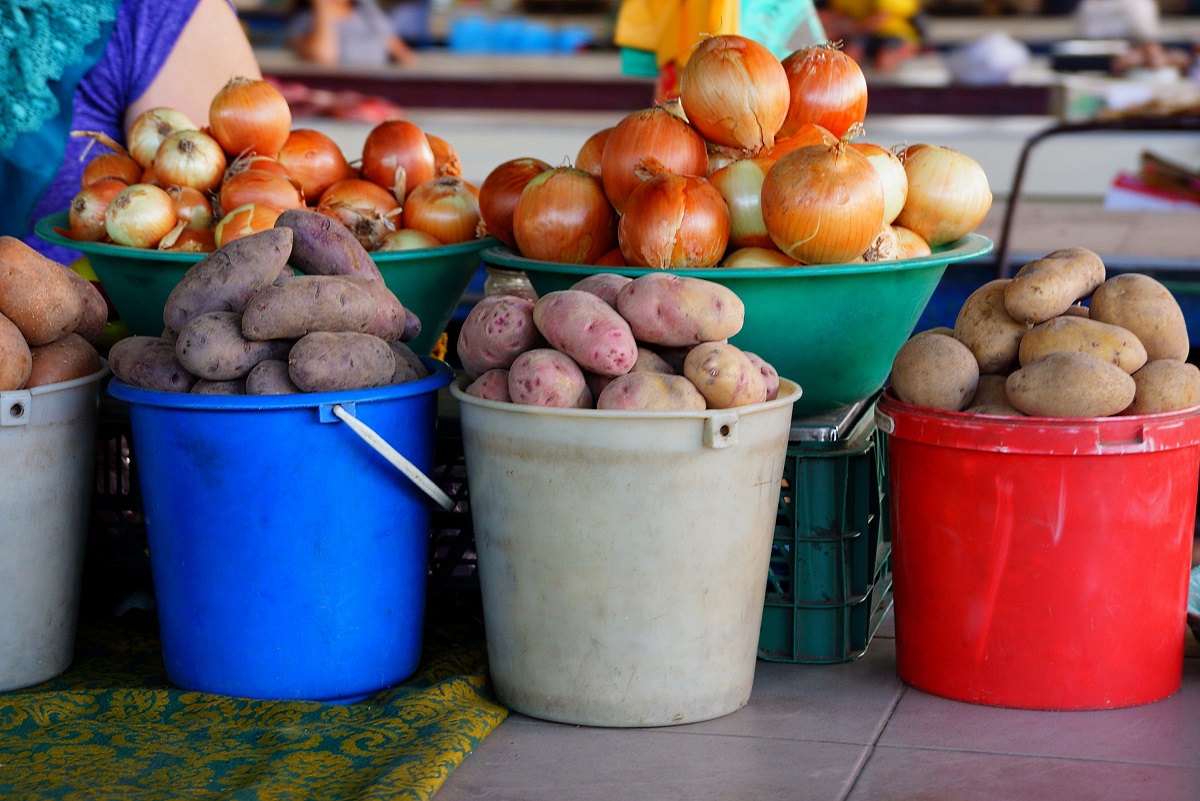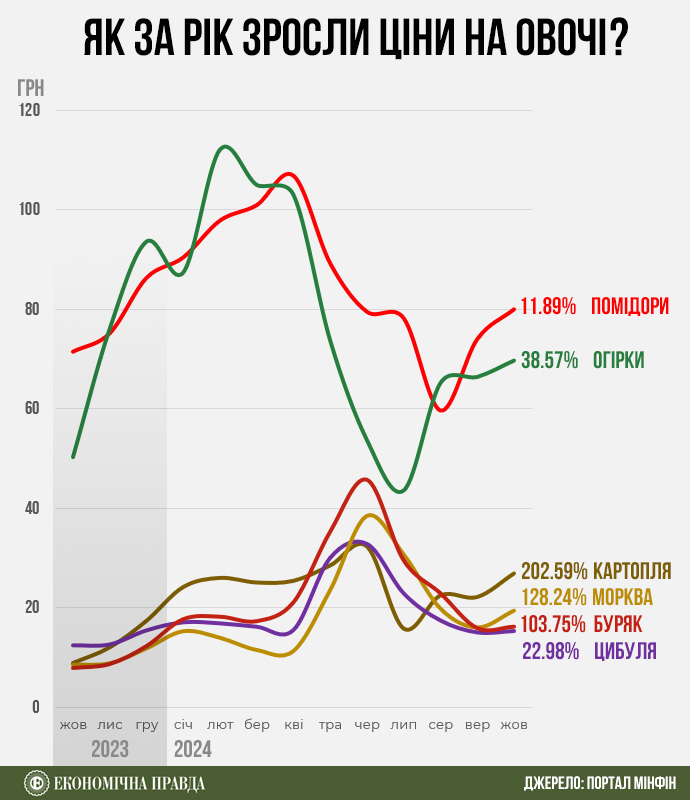Potato prices have surged by 200%. What’s driving the rise in vegetable costs in Ukraine, and what can we expect moving forward?
Subsequently, prices gradually decrease to a minimum that occurs in August, when the harvest is collected and products reach markets and supermarkets. From September to October, the cost of goods increases, peaking in April. This pattern occurs every year.
After the onset of the large-scale war and the occupation of significant territory in the south, vegetable prices rose significantly, but seasonal fluctuations remained unchanged. Only the amplitudes changed.
In 2024, the situation developed such that the summer minimum was far from last year’s, and in autumn, prices began to rise rapidly. The result is that potatoes, tomatoes, and other vegetables are twice as expensive as they were at this time last year.
Why did this happen, and should we prepare for a shortage of traditional vegetables?
Where vegetables are grown
Traditionally, the largest amount of vegetables in Ukraine was grown in the Kherson region. Tomatoes and cucumbers from this region accounted for 40% of the country’s annual harvest or over 90,000 tons. Additionally, Kherson region produced the most onions, peppers, carrots, and eggplants. Until 2022, Mykolaiv region was a distant second in vegetable production with 30,000 tons.
Due to the fighting and the occupation of part of Kherson region, the geography of vegetable production has changed. After losing production in the south, entrepreneurs in other regions sought to fill the market with their products. Some farmers relocated from the frontline areas.
"Ukrainian entrepreneurs focused on relocating their businesses not only to neighboring central regions, such as Dnipropetrovsk, which has always been distinguished by a high level of production, but also to northern regions – Rivne and Zhytomyr, and western ones – Lviv, Volyn, and Ternopil," said Aleksandr Khorev, head of the "APK-Inform: Vegetables and Fruits" project.
A year after the start of the large-scale war, Mykolaiv region emerged as the leading vegetable producer, according to State Statistics data. Yields in the region quadrupled in 2023 compared to 2021, reaching 130,000 tons (almost 50% of all vegetables in Ukraine).

Among the leaders of 2023 are Dnipropetrovsk and Kyiv regions. Western regions – Ternopil, Lviv, and Volyn – are gaining momentum.
This is the primary factor behind high prices.
Where has the potato gone?
In Ukraine, vegetables are primarily grown in open fields, meaning without the use of greenhouses or hothouses. The sector is comprised of small farmers. High temperatures and a lack of rainfall have had several consequences.
Firstly, ground vegetables either failed to yield or were significantly lower in quality, preventing farmers from harvesting the planned amount for sale.
Secondly, even greenhouse vegetables, which were grown in a more controlled environment, suffered from abnormal weather, as auxiliary nets could not completely shield them from the scorching sun.
According to Khorev, agrarians entered the season steadily: the relocation of vegetable production occurred, and the crops that were lacking were replanted, but weather conditions brought their own adjustments.
"From July to September, most areas in Ukraine either saw no rainfall or insufficient amounts. The July heat caused enormous losses. Due to the drought, many crops were lost, and many did not sprout. It affected both the vegetables grown during this period and the sowing of new seeds, such as cabbage or carrots, which are being harvested now," said Denys Marchuk, deputy head of the All-Ukrainian Agrarian Council.
Artificial drip irrigation for plants, where it was available, did not help: the scorching sun damaged even greenhouse vegetables, which were attempted to be covered with films and nets. "Cabbage suffered the most, followed by potatoes, with onions coming in third in terms of losses. However, a lot of onions were planted, so despite the losses, supply exceeds demand," Khorev noted. According to him, the potato harvest has decreased by 20-50%.
The harvest also declined due to farmers shifting towards other crops in an effort to achieve higher profits.
"In 2023, many planted vegetables; however, prices were low compared to 2022. Consequently, in the next season, several farmers decided not to sow the same areas with tomatoes and peppers as it was not profitable. This year, they returned to other crops, which compounded the adverse weather conditions," added Marchuk.

Meanwhile, agrarians are engaged in the standard accumulation of quality vegetables in storage, which can be gradually sold at even higher prices until February 2025. According to Khorev, agrarians are trying to store the potato harvest to earn later, but this strategy may not work if imports enter the market.
Small batches of this crop are already being imported into Ukraine from the Baltic countries. This year, imported products will be of better quality, and high prices in the Ukrainian market will allow exporters to profit even when considering logistics costs. Thus, it is logical that consumers will prefer cheaper and higher quality imports.
The situation is somewhat different with tomatoes and cucumbers. The supply that usually comes from mass harvesting in open fields during the summer did not reach the market. The plants simply did not grow. They only thrived in small farms that could increase irrigation and shield plants from the heat.
Thus, predominantly greenhouse vegetables made their way to supermarket shelves and markets. Such products are more expensive to produce, and yields in greenhouses also decreased due to the heat, resulting in significantly lower supply compared to previous years. Second harvest products from greenhouses arrived at the market later due to the weather. A decrease in supply always means an increase in price. Consequently, vegetable prices are now significantly higher than a year ago.

In the ATB supermarket chain, they say the prices for the borscht set (cabbage, potatoes, carrots) and greenhouse products (cucumbers, tomatoes) have risen the most. Compared to 2023 prices, the increase for these items ranges from 20-100%.
What will happen with prices and the weather
Most likely, vegetable prices will continue to rise. "We have not yet felt the peak of price increases. The trend is that in November-December, the price offering will rise. Unless there is a significant replacement with imports," believes Marchuk.
In ATB, they expect the pace of price growth to be clearer after the harvest in October-November. "In the case of standard yields, no emergency power outages, and with standard storage of products in autumn and winter, we anticipate price increases only on seasonal goods," the chain representatives said.
Currently, there is no mass import of vegetables. Typically, autumn sees the start of tomato and cucumber imports from Turkey, where production costs are lower than in Ukraine. "With the beginning of imports, we will achieve market stability with more or less stable prices, but for now, we have to consume this more expensive product in smaller volumes," Khorev noted.
The analyst also believes that prices for cabbage and potatoes will stabilize with the ongoing harvest, which, under favorable weather conditions, could be more successful. This will allow for the establishment of storage volumes and free up some products for the market. A similar situation exists with late varieties of carrots and other root vegetables.
However, the approaching cold weather plays against price stabilization, as it will compel greenhouses to turn on heating. These are additional costs. If electricity outages return, production costs may rise even more.
Forecasting prices for 2025 is impossible, as the amount of precipitation and temperature records vary from year to year, and farmers may face new challenges.